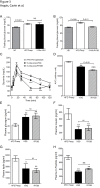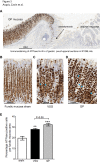Remodeling of the residual gastric mucosa after roux-en-y gastric bypass or vertical sleeve gastrectomy in diet-induced obese rats
- PMID: 25822172
- PMCID: PMC4379088
- DOI: 10.1371/journal.pone.0121414
Remodeling of the residual gastric mucosa after roux-en-y gastric bypass or vertical sleeve gastrectomy in diet-induced obese rats
Abstract
Whereas the remodeling of intestinal mucosa after bariatric surgeries has been the matter of numerous studies to our knowledge, very few reported on the remodeling of the residual gastric mucosa. In this study, we analyzed remodeling of gastric mucosa after Roux-en-Y gastric bypass (RYGB) and vertical sleeve gastrectomy (VSG) in rats. Diet-induced obese rats were subjected to RYGB, VSG or sham surgical procedures. All animals were assessed for food intake, body-weight, fasting blood, metabolites and hormones profiling, as well as insulin and glucose tolerance tests before and up to 5 weeks post-surgery. Remodeling of gastric tissues was analyzed by routine histology and immunohistochemistry studies, and qRT-PCR analyses of ghrelin and gastrin mRNA levels. In obese rats with impaired glucose tolerance, VSG and RYGB caused substantial weight loss and rats greatly improved their oral glucose tolerance. The remaining gastric mucosa after VSG and gastric pouch (GP) after RYGB revealed a hyperplasia of the mucous neck cells that displayed a strong immunoreactivity for parietal cell H+/K+-ATPase. Ghrelin mRNA levels were reduced by 2-fold in remaining fundic mucosa after VSG and 10-fold in GP after RYGB. In the antrum, gastrin mRNA levels were reduced after VSG in line with the reduced number of gastrin positive cells. This study reports novel and important observations dealing with the remaining gastric mucosa after RYGB and VSG. The data demonstrate, for the first time, a hyperplasia of the mucous neck cells, a transit cell population of the stomach bearing differentiating capacities into zymogenic and peptic cells.
Conflict of interest statement
Figures






Similar articles
-
Weight-independent changes in blood glucose homeostasis after gastric bypass or vertical sleeve gastrectomy in rats.Gastroenterology. 2011 Sep;141(3):950-8. doi: 10.1053/j.gastro.2011.05.050. Epub 2011 Jul 12. Gastroenterology. 2011. PMID: 21699789 Free PMC article.
-
Differences in Alimentary Glucose Absorption and Intestinal Disposal of Blood Glucose After Roux-en-Y Gastric Bypass vs Sleeve Gastrectomy.Gastroenterology. 2016 Feb;150(2):454-64.e9. doi: 10.1053/j.gastro.2015.10.009. Epub 2015 Oct 23. Gastroenterology. 2016. PMID: 26481855
-
Comparative Effects of Roux-en-Y Gastric Bypass and Sleeve Gastrectomy on Glucose Homeostasis and Incretin Hormones in Obese Type 2 Diabetic Patients: A One-Year Prospective Study.Horm Metab Res. 2016 May;48(5):312-7. doi: 10.1055/s-0041-111505. Epub 2016 Jan 20. Horm Metab Res. 2016. PMID: 26788926
-
Mechanisms of improved glycaemic control after Roux-en-Y gastric bypass.Dan Med J. 2015 Apr;62(4):B5057. Dan Med J. 2015. PMID: 25872541 Review.
-
Surgical Mouse Models of Vertical Sleeve Gastrectomy and Roux-en Y Gastric Bypass: a Review.Obes Surg. 2019 Dec;29(12):4084-4094. doi: 10.1007/s11695-019-04205-8. Obes Surg. 2019. PMID: 31630327 Review.
Cited by
-
Development of murine bariatric surgery models: lessons learned.J Surg Res. 2018 Sep;229:302-310. doi: 10.1016/j.jss.2018.04.022. Epub 2018 May 10. J Surg Res. 2018. PMID: 29937006 Free PMC article.
-
Bariatric surgery induces a new gastric mucosa phenotype with increased functional glucagon-like peptide-1 expressing cells.Nat Commun. 2021 Jan 4;12(1):110. doi: 10.1038/s41467-020-20301-1. Nat Commun. 2021. PMID: 33397977 Free PMC article.
-
Sleeve Gastrectomy Alters Intestinal Permeability in Diet-Induced Obese Mice.Obes Surg. 2017 Oct;27(10):2590-2598. doi: 10.1007/s11695-017-2670-1. Obes Surg. 2017. PMID: 28429171
-
Diet Change After Sleeve Gastrectomy Is More Effective for Weight Loss Than Surgery Only.Obes Surg. 2017 Oct;27(10):2566-2574. doi: 10.1007/s11695-017-2650-5. Obes Surg. 2017. PMID: 28342156
-
Gastrin Secretion After Bariatric Surgery-Response to a Protein-Rich Mixed Meal Following Roux-En-Y Gastric Bypass and Sleeve Gastrectomy: a Pilot Study in Normoglycemic Women.Obes Surg. 2016 Jul;26(7):1448-56. doi: 10.1007/s11695-015-1985-z. Obes Surg. 2016. PMID: 26613757
References
-
- Sjöström L, Lindroos A-K, Peltonen M, Torgerson J, Bouchard C, Carlsson B, et al. Lifestyle, Diabetes, and Cardiovascular Risk Factors 10 Years after Bariatric Surgery. N Engl J Med. 2004; 351: 2683–2693. - PubMed
-
- Buchwald H, Avidor Y, Braunwald E, et al. Bariatric surgery: A systematic review and meta-analysis. JAMA. 2004; 292: 1724–1737. - PubMed
MeSH terms
Substances
LinkOut - more resources
Full Text Sources
Other Literature Sources
Medical
Research Materials

